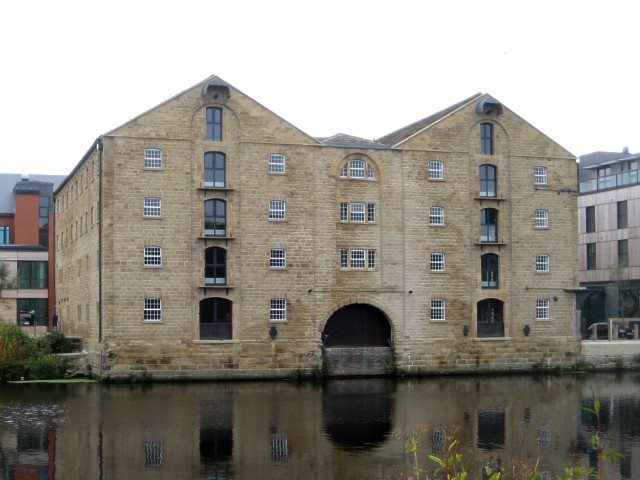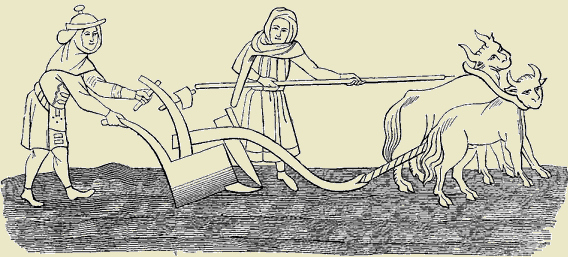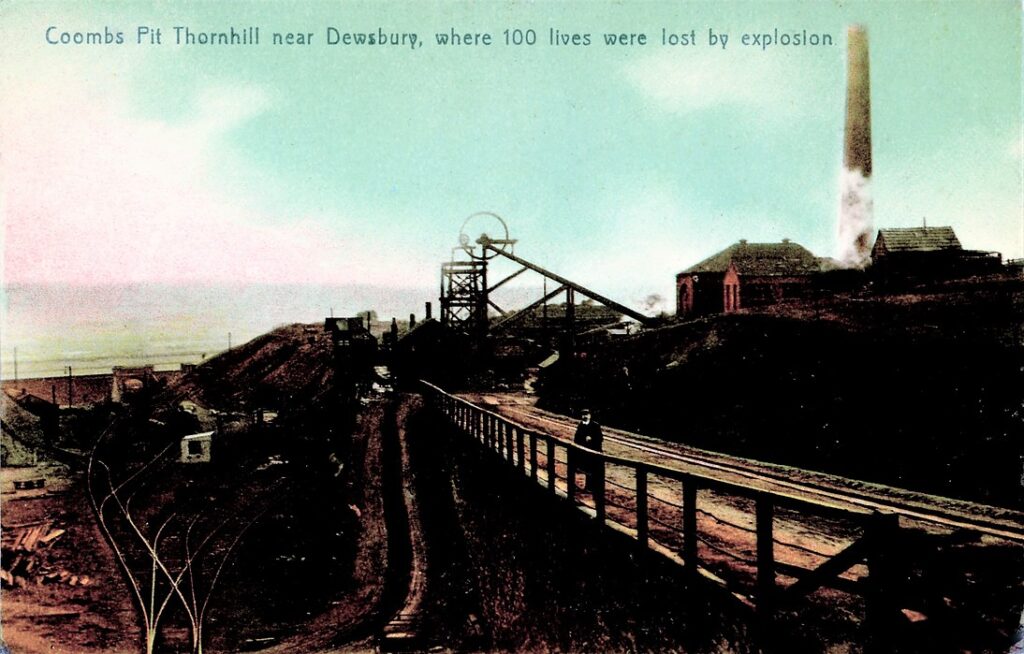Thornhill is a former townshipDivision of an ecclesiastical parish that had civil functions. that became a suburb of Dewsbury in Kirklees, West Yorkshire. Historically in the West Riding of Yorkshire, Thornhill Urban District was absorbed into Dewsbury County Borough in 1910. St Michael and All Angels’ ChurchActive Anglican church in Thornhill, West Yorkshire, Grade I listed. is of ancient foundation and known for its collection of Anglo-Saxon crosses.
Thornhill village is situated on a flat-topped ridge between the River Calder and the valley of the Howroyd Beck and its continuation the Smithy Brook to the south of Dewsbury. The land falls more sharply to the south and the border with SitlingtonAncient township of four villages, renamed from Shitlington to Sitlington in 1929.Ancient township of four villages, renamed from Shitlington to Sitlington in 1929.. The township covered 2486 acres (1,006 ha), and the underlying rock comprises the coal measures of the Yorkshire Coalfield. Thornhill includes Thornhill Edge on the hill top, and Thornhill Lees and Saviletown which developed on lower ground close to the river and navigation.
Geography
Thornhill lies on a roughly triangular plateau on top of a projecting ridge at the eastern edge of the Pennines. The ridge rises from the Calder Valley and to the south is the valley of the Howroyd Beck/Smithy Brook. Thornhill Edge is an escarpment of Middle Coal Measure sandstone, 65 feet (20 m) thick, known as Thornhill Rock.[1] To the north the land slopes more gently to Thornhill Lees, Saviletown and the River Calder. The ancient parishAncient or ancient ecclesiastical parishes encompassed groups of villages and hamlets and their adjacent lands, over which a clergyman had jurisdiction. covered 7816 acres (3,163 ha), of which 2486 acres (1,006 ha) were in the township.[2] No major roads pass through Thornhill, but it is linked to Dewsbury and Horbury Bridge by the B6117.
The Calder and Hebble Navigation
Constructed between 1758 and 1834, the navigation makes the River Calder navigable between Sowerby Bridge and Wakefield in the West Riding of Yorkshire. passes through Thornhill avoiding bends in the river. The Manchester to Leeds Railway closely follows the Calder, and had a station in Thornhill until 1961.
Governance
Thornhill was in the WapentakeAnglo-Saxon administrative unit. of Agbrigg in the West Riding of Yorkshire. Its large ancient parish included FlocktonRural village stretched out along the Barnsley to Huddersfield road in Kirklees, West Yorkshire, taking its name from a Viking settler., SitlingtonAncient township of four villages, renamed from Shitlington to Sitlington in 1929.Ancient township of four villages, renamed from Shitlington to Sitlington in 1929., Whitley LowerVillage near Thornhill in Kirklees, West Yorkshire. and Briestfield. It joined the Dewsbury Poor Law Union in 1837. Thornhill was a civil parishSmallest administrative unit in England. from 1866 and an urban district from1894 when it was enlarged by the addition of Whitley Lower. In 1910 Thornhill was incorporated into Dewsbury Municipal Borough and its successor Dewsbury County Borough.[3]
History
Thornhill was part of the lands given to Ilbert de Laci after the Norman Conquest in 1066. The Domesday Book of 1086 shows that the township had three manors covering four carucates
Old measurement of land. eight oxgangs equals one carucate or ploughland. One oxgang is the area that could be ploughed by a team of eight oxen in one year. worked by three ploughs and had a church and a priest.[4] Jordan de Tornil is mentioned in charters of the late 12th century; his sons adopted the surname de Thornhill, and from one of them the Thornhill family held the manor for several generations.[5]
In 1370 Elizabeth Thornhill inherited the estates as a two-year-old, and the manor was conveyed by marriage to Henry Savile, from whom the estate then descended until the 20th century.[2][6] The Savile family was prominent in Yorkshire with branches in Halifax, HowleyRuined Elizabethan country house in Morley, West Yorkshire, designated a scheduled monument in 1997., Lupset in Wakefield and Methley.
The Saviles lived at the moated and castellated Thornhill Hall.[6] The first Thornhill Hall was a large 13th-century timber-framed building. It was replaced in 1450 by a stone H-plan building that was given a paved floor, plaster walls and a chimney in the 16th century. The hall was at the centre of the Savile estate until 1648 when it was besieged by a Parliamentarian force and either accidentally or deliberately demolished; the Saviles abandoned the site and moved to Rufford Abbey.[7] By the end of the 16th century other prominent families were the Nettletons at Lees Hall and the Radcliffes at Overthorpe Hall.[8]
Industry
In the 17th century most inhabitants made a living from subsistence farming and spinning and weaving woollen cloth in their own homes.[9] Coal was worked on a small scale for local use at the outcrop from the 15th century.[10] The Ingham family began more intensive mining in 1732. The Calder and Hebble Navigation made the Calder navigable between Wakefield and Sowerby Bridge in 1762. Lees Pit and Park Pit were close to the canal in 1802. Cromwell Colliery was sunk further up the hill as workings moved further south. Other pits were Nixons Pit, New Delight and Edge End at the top of the hill. The deep Combs Colliery was sunk in the mid-1850s on land leased from the Saviles.[11] An explosion in 1893 killed 139 men and boys.[12] Mining ended in 1972.[13]
The Manchester to Leeds Railway of 1840 followed the course of the Calder and a station opened in Thornhill. The Lees became a thriving industrial area. John Kilner set up a glass bottle works next to the canal in 1844.[14] Wormald & Walker had built a woollen mill by the Calder in 1820 and a weaving shed was added in 1846. The company made blankets until production ceased in 1986.[15] James Austin arrived in 1840 as a millwright, he built a business that became an iron and steelworks, supplying the Admiralty in the First World War and steelwork for the Air Ministry in the Second. It closed in the 1990s.[16] The Yorkshire Electric Transformer Company on Brewery Lane operated from the 1920s until 1981.[17] Standard Patent Glazing has operated since 1902.[18] Thornhill Power Station supplied electricity from 1902 until 1982, and again from 1998. The generating station was built next to the Calder and Hebble Navigation in Thornhill Lees by the Yorkshire Electric Power Company. Coal was supplied by barge until 1981.[19]
Religion and education
St Michael and All Angels Church has an Anglo-Saxon foundation; a church was possibly built by the 9th century. It was recorded in the Domesday Book of 1086. It is noted for its Anglian crosses, medieval stained glass and monuments to the Savile family, whose association with the village began in 1370.[6]
Holy Innocents Church, a large Gothic Revival church in the Decorated style, was built in 1858 by Mallinson and Healy in Saviletown and closed in 2019.[20] Wesleyan and Primitive Methodists built chapels in Thornhill and Thornhill Lees and Baptists built a church at Thornhill Edge.[21]
When Rector Charles Greenwood died in 1642, he left £500 to endow a grammar school, £250 was to be spent on a school house, and the rest to provide a salary of £20 a year to the schoolmaster. Poorer local boys were educated free of charge.[22] Richard Walker founded a Free School to teach boys and girls reading, writing, and arithmetic in 1712.[2]





